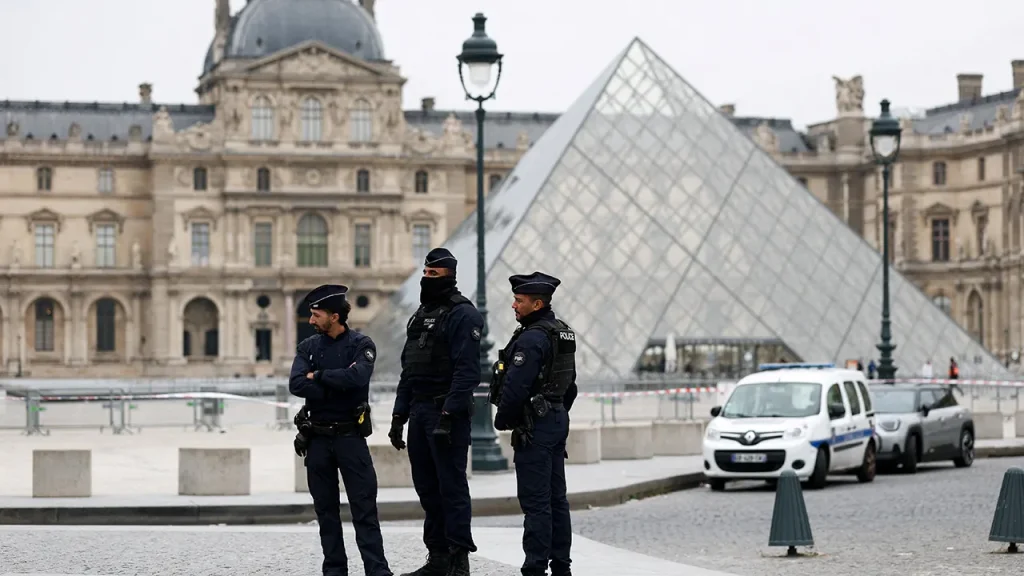The Louvre Heist: A Bold Daylight Robbery of France’s Crown Jewels
In a shocking daylight robbery that has stunned the art world, thieves executed a meticulously planned heist at the Louvre Museum in Paris on Sunday, making off with precious crown jewels of immense historical significance to France. The brazen theft, which occurred while the museum was open to visitors, took less than seven minutes and targeted the museum’s Apollo Gallery, home to treasures linked to Napoleon and French royalty. Tim Carpenter, a former FBI art crime expert, believes this wasn’t a random act but rather a carefully orchestrated operation focused on specific pieces of enormous cultural and historical value. “This was a targeted heist,” Carpenter explained. “They knew precisely what they were going for, and they understood the value and the cultural significance of these pieces. They also understood that this was extraordinarily important to the people of France.”
The timing of the heist—around 9:30 a.m. local time—was strategically chosen, according to Carpenter. “The time is when the museum is kind of its most chaotic. People are getting settled,” he noted. The thieves, reportedly including two disguised as construction workers, showed remarkable preparation by parking next to the museum and using a lift to reach a first-floor window, which they smashed open with an angle grinder. Their efficiency was striking: “These guys are fast and moving quickly with a purpose, and they breach, and they get in there really quickly,” Carpenter observed. The museum was forced to close its doors following the theft, with police immediately launching efforts to recover the stolen items.
Among the treasures stolen were eight objects of immense historical significance, including what’s believed to be a crown belonging to Empress Eugénie, a sapphire diadem, necklace and earring from a matching set linked to 19th-century French queens Marie-Amélie and Hortense. The thieves also made off with an emerald necklace and earrings from Empress Marie-Louise’s matching set, along with a reliquary brooch and Empress Eugénie’s large corsage-bow brooch. Interior Minister Laurent Nuñez confirmed the break-in method in a statement to France Inter radio, saying the thieves “entered from the outside using a basket lift” and “a disc cutter” to slice through glass panes containing the jewels. The ministry emphasized that “beyond their market value, these items have inestimable heritage and historical value.”
The fate of these priceless artifacts now hangs in the balance, with Carpenter suggesting a grim possibility: “They could be melted down or pieced out. They’ll punch stones out of the crowns, and they’ll cut the stones, and they’ll market them individually.” This outcome would be devastating not just for France but for world heritage, as these pieces represent irreplaceable connections to French history. The theft highlights the delicate balance museums like the Louvre must maintain between security and accessibility. “Because it’s a historic building, there are just natural vulnerabilities that occur, and these guys just found one of those and found a way to exploit it,” Carpenter explained. “When you look at a building like the Louvre… there always has to be a balance.”
The audacity of the heist—occurring in broad daylight at one of the world’s most famous museums—raises serious questions about security measures at cultural institutions housing priceless treasures. The Louvre, which welcomes millions of visitors annually, now faces the challenge of reviewing its security protocols while maintaining its accessibility to the public. This incident joins a disturbing global trend of high-profile thefts of cultural artifacts, from museum pieces to archaeological sites, fueling an illicit trade that threatens cultural heritage worldwide. The theft at the Louvre is particularly significant given the iconic status of both the museum and the stolen items, which represent not just monetary value but irreplaceable connections to French national identity.
Despite the sophistication of the heist, Carpenter remains cautiously optimistic about recovery efforts. “I think the local authorities there have a very strong chance of doing a really effective criminal investigation, identifying these perpetrators and hopefully recovering these pieces before they’re lost to us,” he concluded. The investigation is underway, with authorities compiling a detailed list of the stolen items and presumably reviewing security footage and witness accounts. The art world now watches anxiously, hoping these treasures—symbols of France’s royal history—can be recovered before they disappear forever into the shadowy world of illegal art trafficking or, worse, are destroyed for their material components. The theft stands as a sobering reminder of the vulnerability of even our most protected cultural treasures and the ongoing challenges in safeguarding humanity’s shared heritage.


